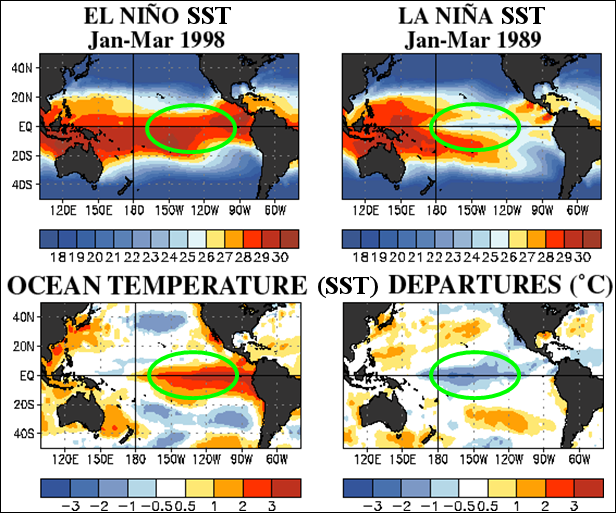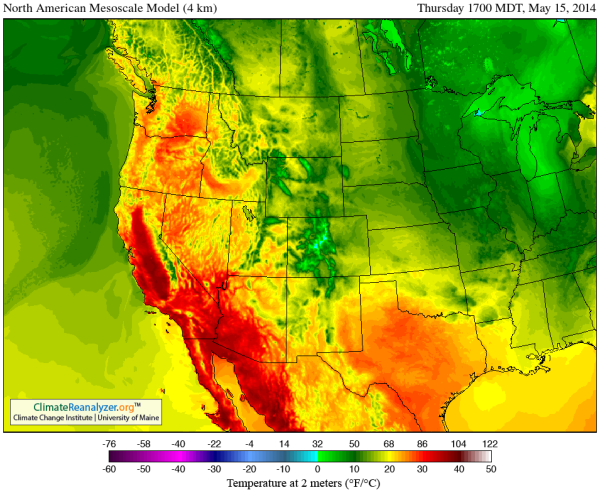
“Humanity already possesses the fundamental scientific, technical and industry know-how to solve the carbon and climate problem. We are not dealing with a failure in technology, a failure in industry, a failure of human ability. We are dealing with a failure of social and political will." Nacala & Socolow 2004
Friday, 30 March 2018
Weather phenomena such as El Niño affect up to two-thirds of the world's harvests
The El Nino and La Nina effects oscillate in relation to low and high systems which moderated by the jet streams. Jet streams themselves have been moderated by climate change making the roller coaster of weather more extreme and likely the El Ninos as well.


Wednesday, 28 March 2018
Poor Climate Change Action in Canada Auditors General March 2018
Canada has missed two separate emission reduction targets (the 1992 Rio target and the 2005 Kyoto target) and is likely to miss the 2020 Copenhagen target as well. In fact, emissions in 2020 are expected to be nearly 20 percent above the target.
http://www.oag-bvg.gc.ca/internet/English/parl_otp_201803_e_42883.html#
http://www.oag-bvg.gc.ca/internet/English/parl_otp_201803_e_42883.html#
Bombora Wave Power
The mWave operates well below the water’s surface, deep enough for most recreational vessels to freely travel over. The mWave can be placed in many more locations than conventional surface wave energy converters. This enables more converters to produce more power closer to where the energy is needed.
The mWave has no exposed moving parts. Our robust rubber membrane extracts power simply without complex mechanisms greatly reducing maintenance requirements. Our replaceable modular design streamlines maintenance, minimising downtime and maximising power output.
The mWave’s lightweight membrane is highly responsive to the full range of wave periods and wave heights enabling it to produce more power in a greater range of sea conditions. The mWave utilises pumped air to harness wave energy, maximising energy extraction in all types of waves. This is a significant advantage over other wave energy converter designs.
Operating on the sea floor provides inherent protection during extreme storm events. The resilient mWave converter also has the unique ability to shut down in extreme storm events. Deflating the mWave of air allows the converter to be progressively detuned to safely extract power or completely shut down. Limiting the loads reduces capital costs and improves the all important cost of electricity.
The mWave has no exposed moving parts. Our robust rubber membrane extracts power simply without complex mechanisms greatly reducing maintenance requirements. Our replaceable modular design streamlines maintenance, minimising downtime and maximising power output.
The mWave’s lightweight membrane is highly responsive to the full range of wave periods and wave heights enabling it to produce more power in a greater range of sea conditions. The mWave utilises pumped air to harness wave energy, maximising energy extraction in all types of waves. This is a significant advantage over other wave energy converter designs.
Operating on the sea floor provides inherent protection during extreme storm events. The resilient mWave converter also has the unique ability to shut down in extreme storm events. Deflating the mWave of air allows the converter to be progressively detuned to safely extract power or completely shut down. Limiting the loads reduces capital costs and improves the all important cost of electricity.
Deepwater’s Offshore Wind Plans Could Revolutionize Mass. Workforce and Offshore Wind Industry
http://www.renewableenergyworld.com/articles/2018/03/deepwater-s-offshore-wind-plans-could-revolutionize-mass-workforce-and-offshore-wind-industry.html
On Tuesday, March 27, Deepwater Wind announced that it plans to assemble the wind turbine foundations for its “Revolution Wind,” a 400-MW offshore wind farm, on the south coast of Massachusetts. Assembly activities will include welding, painting, commissioning and related work for the 1,500-ton steel foundations supporting the turbine tower.
The company said that it has identified three South Coast cities — New Bedford, Fall River and Somerset — as possible locations for this major fabrication activity, which will create 300 direct jobs with an additional 600 indirect and induced jobs that will support this effort.

On Tuesday, March 27, Deepwater Wind announced that it plans to assemble the wind turbine foundations for its “Revolution Wind,” a 400-MW offshore wind farm, on the south coast of Massachusetts. Assembly activities will include welding, painting, commissioning and related work for the 1,500-ton steel foundations supporting the turbine tower.
The company said that it has identified three South Coast cities — New Bedford, Fall River and Somerset — as possible locations for this major fabrication activity, which will create 300 direct jobs with an additional 600 indirect and induced jobs that will support this effort.

Tuesday, 27 March 2018
Renewables generated more electricity than brown coal over summer, report finds
https://www.theguardian.com/australia-news/2018/mar/26/renewables-generated-more-electricity-than-brown-coal-over-summer-report-finds
Continued growth in solar pushed renewable generation in Australia to just under 10,000-gigawatt hours between December 2017 and February 2018. With the Hazelwood plant knocked out of the system last year, brown coal’s output in the same period was just over 9,100 GWh.... A further 5,000 megawatts of large-scale renewables projects were under construction in February, supporting 17,445 jobs.
One of the coal plants that will be closing is the Hazelwood coal plant, the following video is a song composed to say goodbye to the plant.
Continued growth in solar pushed renewable generation in Australia to just under 10,000-gigawatt hours between December 2017 and February 2018. With the Hazelwood plant knocked out of the system last year, brown coal’s output in the same period was just over 9,100 GWh.... A further 5,000 megawatts of large-scale renewables projects were under construction in February, supporting 17,445 jobs.
One of the coal plants that will be closing is the Hazelwood coal plant, the following video is a song composed to say goodbye to the plant.
Monday, 26 March 2018
Canada: Alberta Town Repurposing Oil & Gas Wells for Geothermal Energy
A big part of why newly elected town councillor Dewly Nelson thinks the oil-friendly residents should welcome geothermal to town? It all runs on the same infrastructure and knowledge as the oil and gas industry, making it an excellent way to make use of existing oilfields and some of the workers who have been hit by low oil prices.
https://www.sciencedirect.com/science/article/pii/S096014811100574X
https://www.greengeek.ca/geothermal-power-from-oil-wells/
https://www.sciencedirect.com/science/article/pii/S096014811100574X
https://www.greengeek.ca/geothermal-power-from-oil-wells/
Are Nor’easters and Bomb Cyclones the New Normal?
It seems to me that one of the implications of destabilizing the weather using fossil fuels is the Arctic weather is drifting around where it should not be.
Conditions in the Arctic have gone crazy. In late February, for example, temperatures in some locations spiked more than 50 degrees Fahrenheit above normal. More than a dozen major climate records have been broken in just the past three years: high winter temperatures, low winter and summer sea ice, extensive thawing of permafrost, and so on. But unlike in Las Vegas, what happens in the Arctic does not stay in the Arctic. For almost a decade, scientists have been predicting that rapid Arctic warming may disrupt atmospheric circulation patterns, including the infamous polar vortex, that control winter weather all around the northern hemisphere, including the U.S., northern and central Europe, and northern Asia.
Jennifer Francis, an Arctic and weather specialist at Rutgers University, was one of the first scientists to connect these dots. At an American Geophysical Union conference way back in 2011, she presented a hypothesis and preliminary data analysis indicates that the warming Arctic and related climate changes could conspire to alter the jet stream and extreme weather. She explains the phenomenon nicely in an article that Scientific American released today.
Mangled Jet Stream Delivers Record-Shattering Heat, Extreme Wildfires to California
Mangled Jet Stream Delivers Record-Shattering Heat, Extreme Wildfires to California
The pattern is essentially stuck — featuring a hot, pole-reaching, wave of the Jet Stream continuously rising over the US West, Western Canada and Alaska, and diving deep into the Arctic. It is a condition climate researchers such as Dr. Jennifer Francis attribute to an ongoing erosion and degradation of Northern Hemisphere sea ice. And the predictions of Dr. Francis appear to have born out in both recent observations and cutting edge scientific research showing how sea ice loss has shoved the storm track away from California and the US Southwest (see how Climate Change Made the California Drought Worse).
Mangled Jet Stream
|
Half of Alberta’s boreal forest could disappear due to fires and climate change, study warns
Half of Alberta’s boreal forest could disappear due to fires and climate change, study warns
“That’s why trees are dying,” he said. “They just cannot get the moisture they need to persist.” The research, he said, tells the same story on a much broader scale. “This climate that has supported forests for millennia is basically going beyond that cusp, beyond that point where it can really support trees on the uplands any more.” The changes could have major implications for the forestry sector in Alberta, said Parisien. “If you no longer can have these productive forests on the uplands, there’s going to be a hit to this economy.”


Subscribe to:
Posts (Atom)




